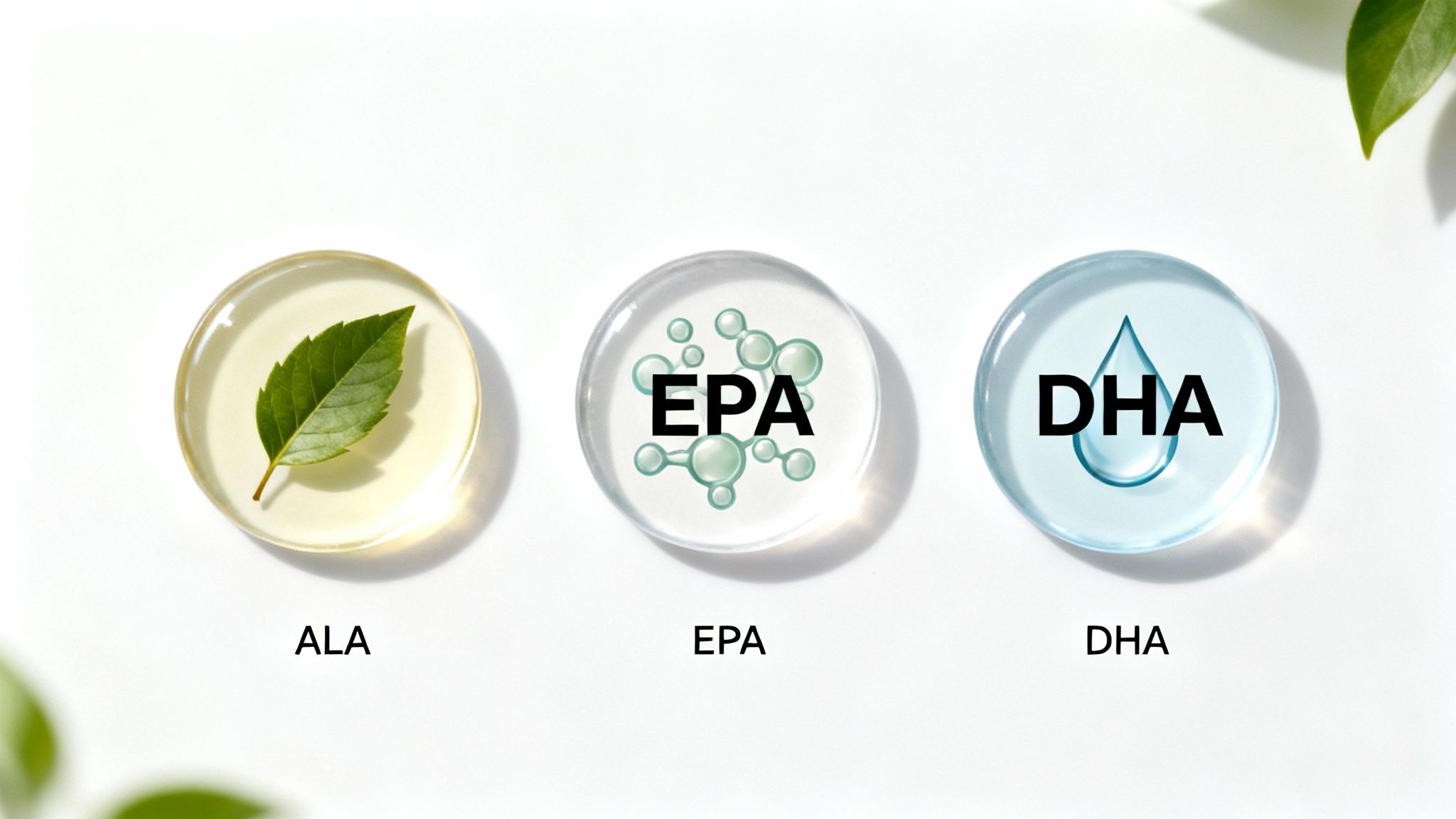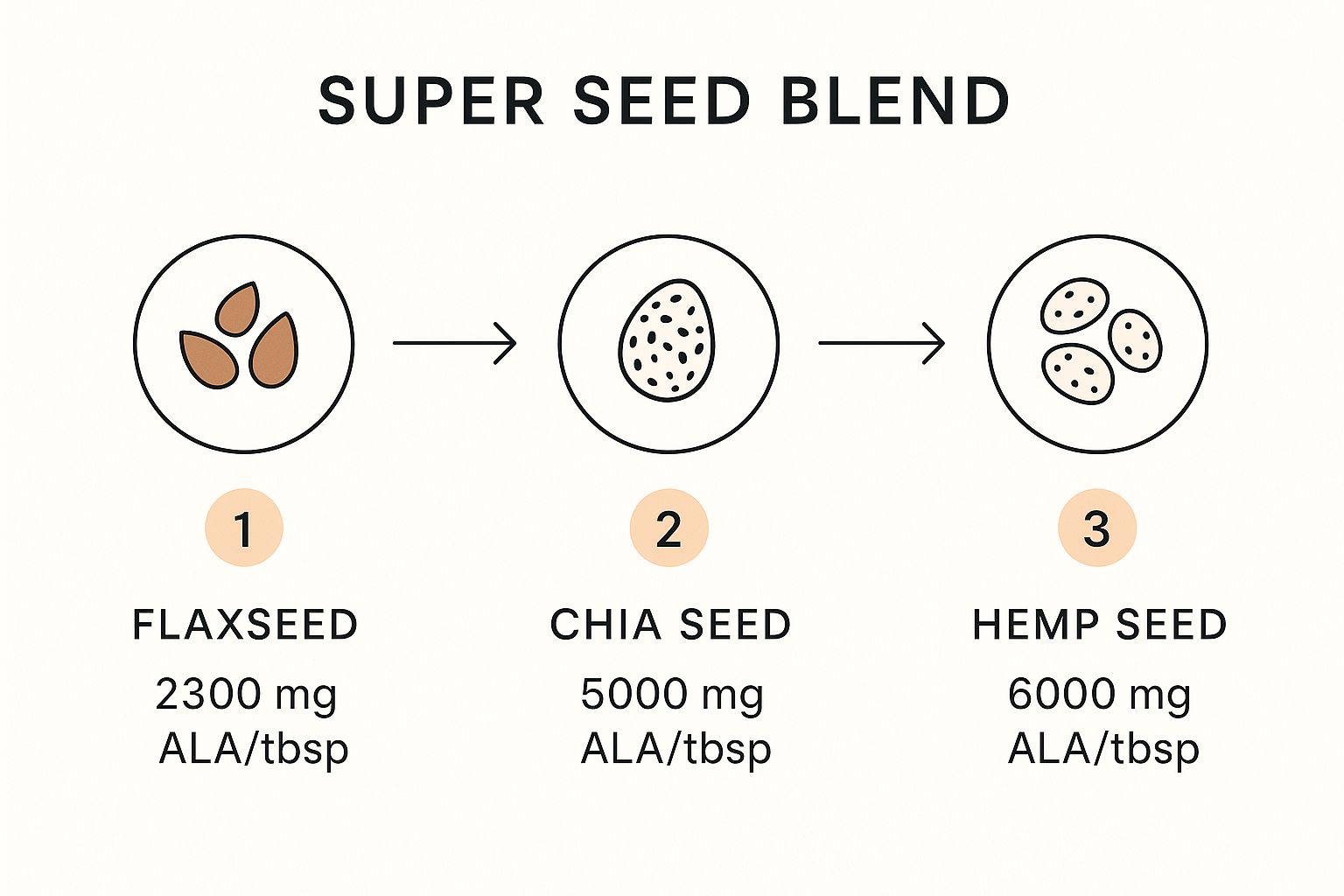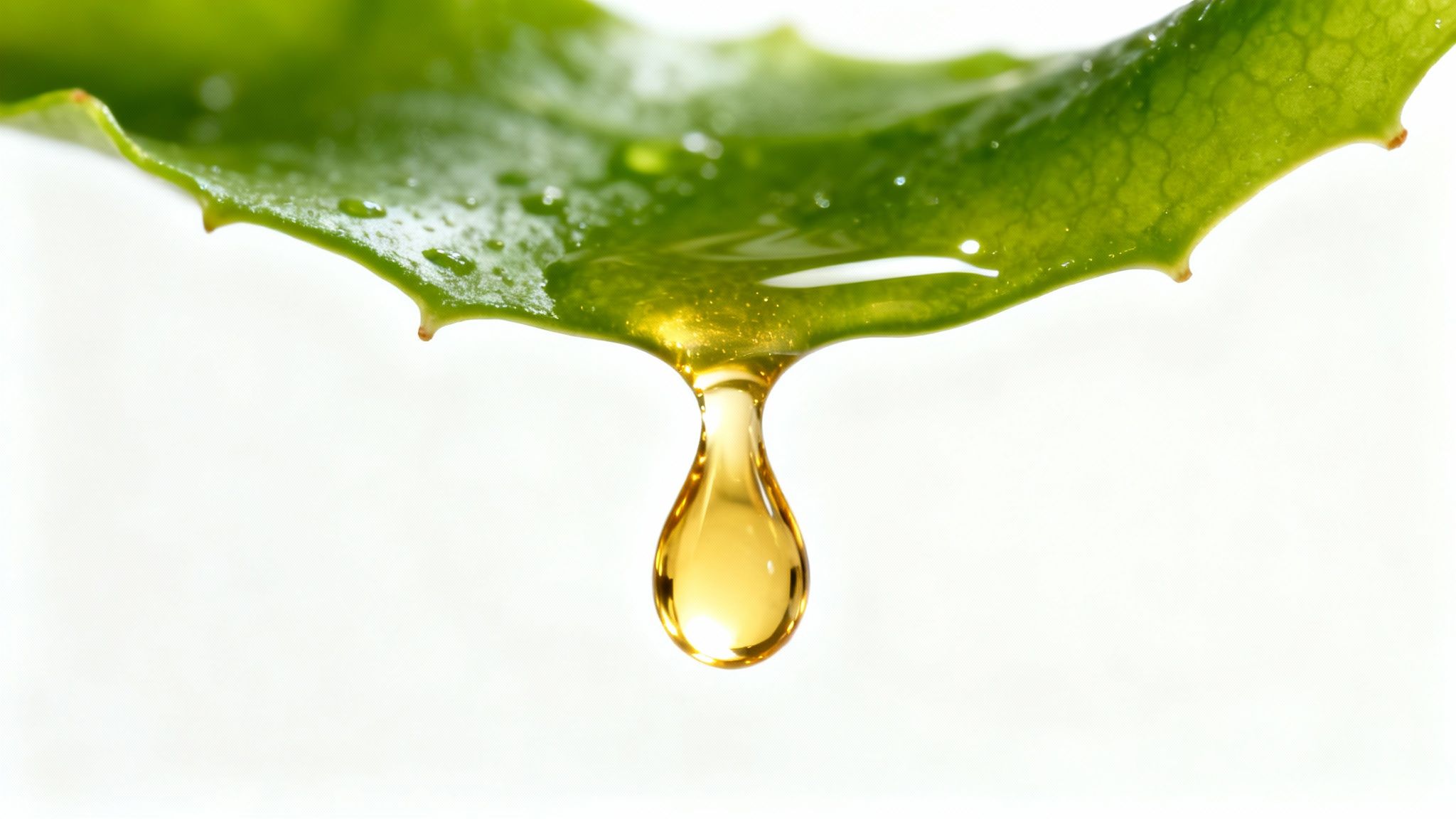How to Get Omega 3 Without Fish: Your Complete Guide
Feeling like you're missing out on essential nutrients just because you don't eat fish? I've been there. Every article seems to point to salmon, leaving you wondering if you're doing enough for your health. Let's clear that up right now. Getting all the omega-3s you need without fish isn't just possible-it's surprisingly simple.
This guide is your roadmap. We’re going to walk through the exact, no-fuss steps to confidently meet your omega-3 goals. No confusing jargon, just practical advice you can use today to support your brain and heart health, fish-free.
What's Coming Up
Here's a quick look at what we’ll cover:
- The Omega-3 Family: We’ll demystify ALA, EPA, and DHA in plain English, so you know exactly what your body needs and why.
- Plant-Powered Foods: You'll get a simple shopping list of the best plant-based foods to stock in your pantry for a steady supply of foundational omega-3s.
- The Algae Advantage: We’ll introduce the game-changing supplement that delivers the most crucial omega-3s-EPA and DHA-directly from the source, no fish required.
This is more than a list of foods; it's about creating a sustainable lifestyle that works for you. Whether you're fully vegan or just cutting back on fish, these tips will make a real difference. And if you're new to this way of eating, our guide on how to transition to a vegan diet is another great resource.
The goal here is simple: to make getting these essential fats feel effortless. You shouldn't have to second-guess your choices. With the right knowledge, you can powerfully and ethically support your health. These fats are famous for their brain-boosting benefits, which you can read more about in this great article on the best supplements for cognitive function, including omega-3s.
Ready to build your fish-free wellness plan? Let’s get started.
The Three Types of Omega-3s You Need to Know

Before we start stocking your kitchen, let’s get to know the omega-3 family. There are three key players: ALA, EPA, and DHA. Think of them as a team where each member has a specific, crucial job. Understanding what they do is the first step to figuring out how to get enough omega-3 without fish.
First up is ALA (alpha-linolenic acid). This is the omega-3 you'll find in most plant foods like flaxseeds, chia seeds, and walnuts. Your body can use ALA for energy, but its main job is to act as a building block for the other two.
Here’s the thing, though: your body can convert ALA into EPA and DHA, but the process is notoriously inefficient. I do NOT think relying on this conversion alone is a good strategy, and it’s the most important detail for anyone on a fish-free diet to understand.
Why EPA and DHA Are the Real MVPs
Now, let's talk about the heavy hitters: EPA (eicosapentaenoic acid) and DHA (docosahexaenoic acid). These are the two forms directly responsible for the amazing brain, heart, and anti-inflammatory benefits we hear so much about.
EPA and DHA are the "active" forms your body can use immediately, no extra steps required. If ALA is the raw lumber, then EPA and DHA are the finished furniture. Your body is great at using the furniture but not so great at building it from scratch.
The poor conversion rate is a huge deal. It means that just eating a ton of flaxseeds probably isn't enough to get the EPA and DHA levels your body needs to thrive. This is a common pitfall that can leave you with a nutritional gap, even if your diet is otherwise stellar.
A single ounce (28 grams) of flaxseeds delivers an incredible 6,388 mg of ALA. But our bodies don’t do much with it.
A review from the National Institutes of Health shows that less than 10% of ALA gets converted to EPA, and for DHA, it's often less than 5%. What this means for you is that relying only on plant foods for these critical nutrients can leave your levels lagging.
So, what's a plant-based eater to do? You need a direct source of these power players. Let's find out where to get them.
Stocking Your Pantry with ALA Powerhouses

Ready to make your kitchen a hub for plant-based omega-3s? Getting your daily dose of ALA is surprisingly easy once you know which ingredients to reach for. Let's talk about the heavy hitters that should become staples in any kitchen: flaxseeds, chia seeds, hemp seeds, and walnuts. These aren't just trendy health foods-they're your most reliable sources for foundational ALA.
Think of these foods as your daily go-tos for hitting those omega-3 targets. But simply sprinkling them on oatmeal and calling it a day isn't going to cut it long-term. To really make them a non-negotiable part of your routine, you have to get creative.
The Super Seed Trio
Flax, chia, and hemp seeds are tiny but incredibly mighty. A fantastic strategy I use myself is creating a "super seed" blend. I just mix equal parts of all three in a jar and keep it in my fridge for easy access.
This blend becomes an effortless addition to so many meals:
- Smoothies: A tablespoon or two adds a creamy texture and a nutritional punch without changing the flavor.
- Yogurt Bowls: Sprinkle it over plant-based yogurt with berries for a satisfying, nutrient-dense crunch.
- Baked Goods: Mix it into muffins, pancakes, or homemade energy balls for a hidden boost of healthy fats.
It’s a simple way to consistently get those essential fats without much thought.

Beyond the Seeds: Creative Ways to Use Walnuts
Walnuts are another fantastic ALA source, packing about 2,500 mg of ALA into a single one-ounce serving. Their rich, buttery flavor makes them incredibly versatile.
Instead of just grabbing a handful for a snack, try thinking outside the box:
- Creamy Pasta Sauce: Soak raw walnuts in hot water, then blend them with garlic, lemon juice, and nutritional yeast for a decadent, dairy-free alfredo-style sauce.
- Plant-Based "Meat": Pulse walnuts in a food processor with mushrooms and spices to create a hearty base for tacos or bolognese.
- Next-Level Salad Topper: Lightly toasting them in a dry pan for a few minutes completely transforms their flavor.
My personal "quick win" is making a big batch of walnut pesto. It's a game-changer for quick weeknight meals. Just blend walnuts, fresh basil, garlic, and olive oil. It's perfect on pasta, sandwiches, or drizzled over roasted veggies.
Don't Forget These Other Players
While those four are your mainstays, diversifying your intake is always a smart move. Other plant foods contribute to your daily ALA total too.
Keep an eye out for these on your next grocery run:
- Edamame: A fantastic source of protein and fiber, one cup of shelled edamame also provides around 500 mg of ALA.
- Brussels Sprouts: Roasting brings out their best flavor, and a one-cup serving offers over 250 mg of ALA.
- Kidney Beans: Perfect for chilis and stews, a cup of these hearty beans contains about 400 mg of ALA.
By stocking your pantry with these ALA powerhouses, you build a strong foundation for your omega-3 needs, making healthy eating a simple, delicious habit.
Bridging the Gap with The Power of Algae Oil

So, we've established that counting on your body to turn plant-based ALA into EPA and DHA is a bit of a long shot. The conversion rate is frustratingly low, which can easily leave you deficient. But what if you could just skip that unreliable step entirely?
This is where algae oil comes in. It's the ultimate fish-free omega-3 solution. Here’s a little-known fact: fish don't actually produce their own omega-3s. They get them by eating microalgae. By going straight to the source, you get a pure, potent, and direct supply of the good stuff your body craves.
Why Algae Oil Is a Game Changer
Algae oil isn’t just a substitute for fish oil; in many ways, it's a superior choice. Fish oil often carries the risk of ocean contaminants like mercury. In contrast, the algae used for supplements is grown in controlled, clean environments. You get all the benefits, none of the baggage.
Best of all, it delivers EPA and DHA in a form your body can absorb and use immediately. No conversion necessary. It’s like a direct deposit of the most important omega-3s, ready to support your brain and heart.
The market reflects this shift. The demand for vegan omega-3 supplements was valued at over USD 1.6 billion in 2023 and is expected to nearly double by 2030, according to Grand View Research. What this means for you is that clean, effective alternatives are becoming the new standard.
Making It Part of Your Routine
For anyone committed to a fish-free diet, an algae oil supplement isn't just a nice-to-have-it's a cornerstone of a solid wellness plan. This is the most reliable way to get the powerful benefits of EPA and DHA.
When our founder, Sam, was struggling with his own health journey, finding clean, plant-based solutions that actually worked was a huge challenge. He knew there had to be a better way to get crucial nutrients like omega-3 without compromise. This frustration was the spark that led to Yuve.
This is exactly why we created Yuve Vegan Omega-3. We use high-quality algal oil to deliver a clean, effective dose of both EPA and DHA, designed to fit seamlessly into your life. A targeted supplement is one of the smartest things you can do, a topic we explore more in our guide to the best supplements for a vegan diet.
By pairing your daily plant-based ALA sources with a dependable algae oil supplement, you build a complete and powerful omega-3 strategy. You get everything you need, no fish required.
A Day of Fish-Free Omega-3 Eating
https://www.youtube.com/embed/1YJWdv_guXQ
Theory is one thing, but seeing how this all fits into a real, busy day can make all the difference. Let's walk through what a power-packed day of fish-free omega-3 eating actually looks like. This isn’t about a restrictive meal plan-it’s about making smart, simple choices that add up.
Morning Fuel for a Sharp Mind
Your day starts with a golden opportunity to get a head start on your ALA intake. A warm bowl of oatmeal is the perfect canvas.
- The Base: Start with ½ cup of rolled oats cooked with water or your favorite plant-based milk.
- The Omega-3 Boost: Stir in one tablespoon of ground flaxseed and top it off with a small handful of walnuts. Right there, that simple combo gets you well over your daily ALA target.
- The Flavor: Add some berries for antioxidants and a drizzle of maple syrup for sweetness.
This breakfast is also loaded with fiber to keep you feeling full and focused all morning long.
A Satisfying Midday Meal
Lunchtime is another easy win. A hearty lentil salad is perfect for meal prep and gives you a fantastic mix of protein, fiber, and healthy fats. Just toss cooked lentils with chopped cucumber, tomatoes, red onion, and parsley. For the dressing, mix olive oil, lemon juice, and salt. To finish it off, sprinkle two tablespoons of hemp hearts over the top for a nutty flavor and another solid dose of ALA.
When you're taking lunch on the go, convenient storage is a lifesaver. It’s worth exploring options like collapsible silicone food containers to make portability easier.
Dinner and Your Daily EPA and DHA Insurance
For dinner, a flavorful tofu and broccoli stir-fry is a quick and satisfying option. Just pan-fry firm tofu until golden and toss it with steamed broccoli and a soy-ginger sauce. Serve it over quinoa for a complete protein.
Now, for the most important step. Remember that ALA-to-EPA/DHA conversion gap? This is where you close it for good.
I take my Yuve Vegan Omega-3 supplement with my evening meal. Taking it with food helps with absorption, and it just becomes an easy habit. This single step ensures I’m getting the direct, potent EPA and DHA my body needs for brain health and inflammation support-something my plant-based meals alone can't guarantee.
If you need a simple evening snack, a handful of edamame works perfectly. And for more inspiration, check out our guide to 10 healthy snacks for traveling.
Quick Wins: Your Omega-3 Checklist
Here’s your simple game plan to get all the omega-3s you need, without any guesswork.
- Eat Your ALA Daily: Add one tablespoon of ground flaxseed to your morning smoothie or grab a small handful of walnuts for a snack.
- Supplement for EPA & DHA: This is the crucial part. Take a high-quality algae oil supplement every day to bypass the poor conversion rate and get the omega-3s that matter most.
- Stock Your Pantry: Keep flaxseeds, chia seeds, hemp hearts, and walnuts on hand so they're always ready to go.
A good supplement is your daily wellness insurance. It's the most foolproof way to guarantee you're getting the optimal dose of EPA and DHA. Yuve's Vegan Omega-3 gives you that clean, direct source of EPA and DHA, so you get all the incredible benefits without the fishy business.
Ready to put this into action? I’d love to hear how it goes-drop your own tips in the comments below!
Answering Your Questions About Fish-Free Omega-3s
Diving into the world of plant-based omega-3s can feel a little confusing, but it doesn't have to be. Let's tackle some of the most common questions I hear so you can move forward with confidence.
Can I Really Get Enough EPA and DHA Just From Flax and Chia Seeds?
This gets right to the core of the issue. Flax and chia seeds are fantastic-for ALA. But your body is not very good at converting that ALA into the long-chain forms, EPA and DHA, that do the heavy lifting for your brain and heart. The conversion rate is often shockingly low, sometimes less than 5%. Because of this, relying only on seeds is a gamble. You'll get plenty of ALA, but you'll likely fall short on the others. This is why a direct source, like an algae oil supplement, is the most foolproof way to bridge that gap.
Is Algae Oil Actually as Good as Fish Oil?
Yes, and in my book, it's even better. Studies show that algae oil is just as effective as fish oil at raising your blood levels of EPA and DHA. Think about it: where do fish get their omega-3s? They eat algae. By choosing an algae oil supplement, you're cutting out the middleman and going straight to the clean, original source. It's more sustainable, and you don't have to worry about the heavy metals and microplastics common in our oceans.
So, How Much Plant-Based Omega-3 Do I Need Every Day?
Let's break it down. For ALA, the daily target is pretty easy to hit. The general guideline for adults is:
- 1.1 grams for women
-
1.6 grams for men
You can easily get this from a single tablespoon of ground flaxseed or a small handful of walnuts.
For the real powerhouses, EPA and DHA, the recommendation from most health organizations is a combined 250-500 mg per day. The most reliable and efficient way to hit this target consistently is with a quality algae oil supplement.
Ready to make fish-free omega-3s an effortless part of your routine? Yuve Vegan Omega-3 provides a clean, potent dose of EPA and DHA sourced directly from algae, giving you the peace of mind that your brain and body are getting exactly what they need to thrive.
